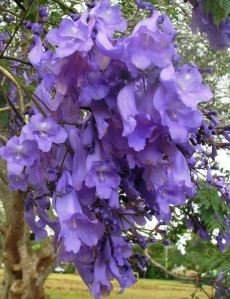In my part of the world we know it’s spring because the jacarandas are in bloom, throwing a delicate blushed-blue shawl across the mountain.
In early spring, a month back now, there is a sudden bright flourish of colour from the azaleas and the bulb plants and the ornamental peaches but this soon fades to a dusty hiatus as we wait for the rains and the bold floral flaunt of summer. This gap is filled, very nicely, by the jacarandas that help us to accept the dry and dusty conditions of high spring.
They are forever associated in our minds with exam time; many a student has sat with head bowed over a last-minute cram beneath the kindly canopy of a jacaranda tree, feet pooled in blossom. This memory stays long after the coruscating mix of hope and dread has been forgotten.
I have a strong emotional connection with several trees and among my favourites the jacaranda stands at Number Two – first place being held by the poinciana, of which I shall write in a couple of months. Though they both are trees of south and central America they are the signature trees of my African childhoold and I sometimes wonder if they helped dictate my choice of location when I grew up and had to change countries. It’s true, I would find it hard to live in a place where there were no jacarandas and poincianas.
Of the two, the jacaranda is the more modest and reticent. Its canopy is not dense when in leaf; its long, ferny, mimosa-like foliage lets in a lot of light and its flowers have an individual delicacy that depend on abundance for full effect. A jacaranda in full bloom is a heart-contenting site rather than on which stops the heart; a street of jacarandas is a sight that soothes and pleases rather than trumps the eye.
It’s all to do with the colour and words fail most of us when we try to describe a flower that is made up of subtle tints which have no adequate adjectival definition. “Mauve” is usually the best we can do, trying to simplify a shade of colour that lies somewhere between lilac and lavender. Nor are all jacaranda flowers precisely the same shade; some are richer and deeper than the norm, tending more to blueness, while others show pinker tones. There is a youngster of that colour outside my window as I write. (And of course there is a white form, but, lovely though it is, we real jacarandaphiles don’t count it!).
The origin of the name “Jacaranda” is believed to be of Brazilian or Guarani origin and I’ve read at least one source that says it means “strong odour”. This is surprising, given that the flowers give out only the faintest slightly dusty scent. Nor is the wood particularly odoriferous. It’s a pretty name and rhymes nicely with “verandah” to give people here a sense of lounging through the warm spring days in the deep and fretted-timber shade of an old Queenslander, its tin roof overhung with a spreading branch of jacaranda that sheds a soft scattering of blossom.
Jacarandas give of their best in dry springs – and this has been one of the driest for many years, on our green mountain. Up here they bloom later than down on the plains, or in the valleys to the west and they do so in a delicious duet with the agapanthus, whose colour is in perfect harmony. A jacaranda overhanging a bed or border of aggies is a sight to soothe the sorest of eyes.
Today I walked down a road lined with jacarandas and scuffed through the fallen flowers as I did so, loving the luxurious feeling of being bathed all over with a benign blue-mauve light. They won’t be with us very long, these flowers of the southern spring, so we relish them and treasure them in our hearts until next spring.
And never mind, because when the last blossom has fallen the leaves will have formed in full, giving us the shade we crave throughout the hot summer, before themselves dropping, briefly, in winter to allow us the warm sun. Truly, they are a perfect tree for this place and this climate. And yet, because jacarandas have shown a small and (so far) very modest tendency to run wild, in a land where so many large areas are smothered by exotic weeds these beloved and iconic trees are in danger of – quite literally – getting the chop.
Certainly they are tough performers under hard conditions – but weeds?! Luckily they are not overly profuse seeders and any unwanted seedlings can be easily pulled out. I find it almost physically painful to do this – to kill an aspiring jacaranda – but I do, for the sake of preserving those fine and flourishing old trees that grace our neighbourhood, and a few of their progeny too, so that they don’t get on any local bureaucrat’s Public Enemy list.
Jacarandas have been here a long time now and they are as firmly rooted in our hearts and minds as they are in the ground. How else would we know it’s October? How else would another generation of students find the inspiration to tackle their exams?
Not too far south of here is a town where the streets are lined with jacarandas and they celebrate the flowering each year with a special festival. I think we should do this throughout the region where our jacarandas grow – it’s the least we can do for a tree that gives so much and asks so little.



